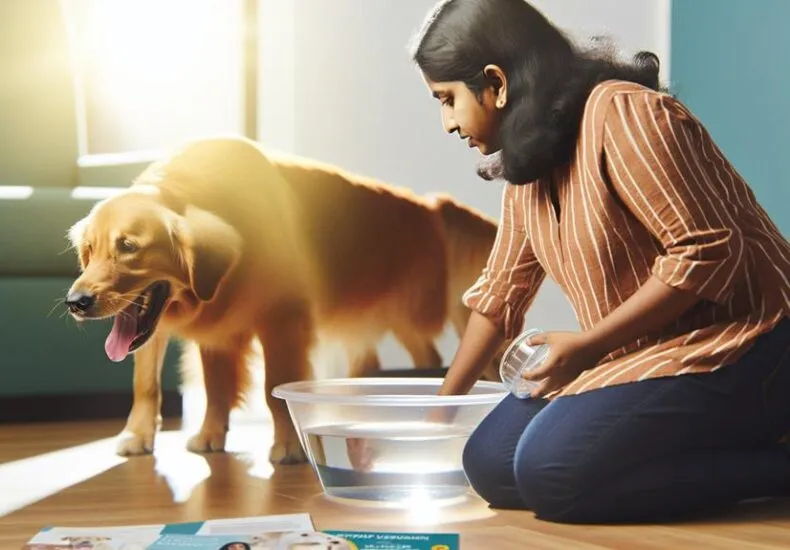
Why Is My Dog Drinking so Much Water
Imagine your dog lapping up water like it's the last drop in the desert, raising questions about their health and well-being. You might wonder why this sudden thirst has taken hold of your furry companion. Increased water intake can sometimes signal underlying health issues or even be influenced by diet or medications. As you observe these changes, it's important to reflect on what might be causing this behavior and when it's time to seek professional guidance. Understanding these factors could be essential for your dog's health and comfort.
Normal Thirst Levels in Dogs
When it comes to your dog's hydration needs, understanding normal thirst levels is vital. Dogs typically require about one ounce of water per pound of body weight daily. However, factors like age, activity level, and environmental conditions can influence these needs. For instance, an active dog or one exposed to hot weather may drink more, while a sedentary dog may consume less.
Normal hydration is essential for your dog's overall health, as it affects bodily functions, including temperature regulation, digestion, and waste elimination. A well-hydrated dog will drink regularly throughout the day, showing a balanced approach to thirst regulation. You should observe your dog's drinking habits to establish what's typical for them.
Keep in mind that individual variations exist; some dogs may naturally drink more or less than the average. A sudden change in your dog's water intake can indicate a problem, so it's important to be aware of their normal patterns. You can monitor their hydration by checking the moisture of their gums and how quickly the skin returns to its normal position when gently pinched.
If you notice your dog consistently drinking more or less than usual, consider factors such as diet, exercise, and health conditions that might affect their thirst. By understanding normal thirst levels, you can better support your dog's hydration needs and overall well-being. Regular check-ups with your veterinarian can also help guarantee that your dog's hydration remains within a healthy range.
Signs of Excessive Thirst
Keeping an eye on your dog's hydration habits is important, especially if you notice any signs of excessive thirst. If your furry friend is drinking more water than usual, it's vital to observe their behavior closely. One of the first signs you may notice is an increase in the frequency of drinking. If your dog is consistently finishing their water bowl and seems to be asking for more, this could indicate a problem.
You may also observe changes in their bathroom habits. Excessive thirst often leads to increased urination. If your dog is needing to go outside more frequently or has accidents indoors, it could signal that something isn't right. Additionally, watch for any behavioral changes. If your normally active dog becomes lethargic or seems disinterested in playtime, this could be a concerning sign related to their hydration habits.
Another indicator of excessive thirst is if your dog is excessively licking their lips or showing signs of dehydration, such as dry gums or a lack of elasticity in the skin. These symptoms can point to underlying health issues that require attention.
Common Causes of Increased Thirst

If your dog is drinking more water than usual, it could be a sign of underlying health issues like Diabetes Mellitus or kidney disease. Diabetes often presents with symptoms such as increased urination and weight loss, while kidney disease may be indicated by lethargy and a decreased appetite. Recognizing these symptoms early can be vital for effective treatment, so it's important to consult your veterinarian.
Diabetes Mellitus Symptoms
Noticing your dog drinking excessive amounts of water can be concerning, and one of the common causes behind this behavior is diabetes mellitus. This condition occurs when your dog's body either doesn't produce enough insulin or becomes resistant to it, leading to elevated blood sugar levels. As a result, your dog may exhibit several symptoms that warrant attention.
Here are some signs of diabetes mellitus in dogs:
- Increased thirst (polydipsia)
- Frequent urination (polyuria)
- Weight loss despite a normal or increased appetite
- Lethargy or decreased energy levels
These symptoms arise because the body is unable to properly utilize glucose, leading to insulin resistance. Consequently, the excess blood sugar spills over into the urine, drawing more water with it, which explains the increased thirst. If you notice these signs, it's essential to consult your veterinarian. Early diagnosis and management can help prevent complications and improve your dog's quality of life. Addressing diabetes mellitus involves monitoring blood sugar levels and, in many cases, administering insulin therapy. Remember, the sooner you act, the better the outcome for your furry friend.
Kidney Disease Indicators
Many dog owners might be surprised to learn that kidney disease is another important reason for increased thirst in their pets. When a dog's kidney function declines, it struggles to filter waste products and toxins effectively. This inefficiency can lead to a buildup of waste in the bloodstream, prompting your dog to drink more water in an attempt to maintain hydration balance.
As the kidneys lose their ability to concentrate urine, dogs often produce larger volumes of dilute urine. Consequently, they become increasingly thirsty, seeking to replenish lost fluids. Other indicators of kidney disease may include weight loss, decreased appetite, vomiting, and lethargy. If you notice these symptoms alongside excessive drinking, it's essential to consult your veterinarian.
Early detection of kidney issues can greatly enhance your dog's quality of life. A vet may recommend blood tests and urinalysis to assess kidney function and determine the underlying cause of increased thirst. By addressing kidney health proactively, you can help guarantee your pet stays hydrated and maintains overall wellness. Remember, understanding the signs of kidney disease is fundamental for your dog's health and happiness.
Dietary Influences on Water Intake
Your dog's diet can greatly impact their water intake, with dry food often requiring them to drink more to stay hydrated. Additionally, the salt content in their meals can influence thirst levels, prompting them to seek more water. It's also important to take into account how nutritional additives in their diet may affect their overall hydration needs.
Dry Food Impacts Hydration
The type of food you choose for your dog can greatly influence their hydration levels. Dry food types, which typically contain less moisture content than wet food, can lead to increased water intake. When your dog consumes dry kibble, they may need to drink more water to compensate for the lack of moisture in their diet. This can be especially important for dogs with certain health conditions that require proper hydration.
Here are a few factors to take into account regarding dry food and hydration:
- Moisture Content: Most dry dog foods contain about 10% moisture, while wet foods can have up to 80%.
- dietary needs: Some dogs may require more water due to their activity level or health issues.
- Food Quality: Higher-quality dry foods may have better ingredients, impacting overall hydration.
- Transitioning: If you're switching from wet to dry food, monitor your dog's water intake closely.
Salt Intake Considerations
Excessive salt intake can considerably influence a dog's water consumption. If you've noticed your dog drinking more than usual, it could be due to increased sodium in their diet. High levels of salt can lead to dehydration, causing your pet to seek out more water to compensate. Understanding the salt sources in your dog's food is crucial for managing their hydration.
Here's a quick overview of common salt sources and their sodium effects:
| Salt Source | Sodium Content | Potential Effects |
|---|---|---|
| Commercial dog food | High | Increased thirst, possible kidney strain |
| Processed treats | Moderate to high | Dehydration, increased urination |
| Table scraps | Variable | Unpredictable sodium intake, digestive issues |
It's essential to read ingredient labels and monitor your dog's salt intake. If you suspect their dietary sodium is too high, consult your veterinarian. They can help assess your dog's diet and suggest appropriate adjustments to maintain balanced hydration without excessive thirst. Keeping your dog's salt levels in check can lead to a healthier, more comfortable life for them.
Nutritional Additives Effects
Understanding how dietary choices affect hydration goes beyond just salt intake. Nutritional additives and supplements can greatly influence your dog's water consumption and overall hydration balance. When you introduce new supplements into your dog's diet, the effects on thirst and water intake can vary. Here are some factors to take into account:
- Protein levels: High-protein diets can lead to increased thirst as your dog's body works to metabolize excess protein.
- Fiber content: Increased fiber can absorb water, potentially requiring your dog to drink more to maintain hydration.
- Fat content: Certain fats can influence hydration needs, as they may require additional water for digestion.
- Vitamins and minerals: Specific nutritional supplements, like those high in certain minerals, can cause your dog to drink more water to balance electrolytes.
Always observe how your dog responds to any changes in their diet. If you notice a considerable increase in water intake, it might be worth consulting your veterinarian. Balancing nutritional supplements with appropriate hydration is essential for your dog's health and well-being.
Health Conditions to Consider

When a dog suddenly starts drinking an unusually high amount of water, it can be a signal that something isn't quite right with their health. Several health conditions could be at play, and it's important to recognize them early. One common cause is diabetes mellitus, which leads to excessive thirst and urination, often accompanied by behavioral changes like increased appetite. Cushing's disease is another possibility; it results in hormonal imbalances that can make your dog drink more than normal.
Kidney disease might also be a concern. As the kidneys struggle to filter toxins, your dog may compensate by drinking more water. If you notice any sudden weight loss or changes in energy levels, these could be additional indicators of kidney issues.
Don't overlook the potential influence of environmental factors. For instance, if your dog is exposed to heat or changes in their environment, such as moving to a new home, they may increase their water intake as a natural response.
Additionally, certain medications can cause increased thirst. If you've recently started a new treatment for your dog, reviewing the Side effects is essential.
Lastly, infections or illnesses can lead to a spike in water consumption. Pay attention to any other symptoms, like vomiting or lethargy, as they can give you a clearer picture of your dog's health. Understanding these health conditions is vital to ensuring your dog remains happy and healthy.
When to Consult a Veterinarian
If you notice your dog's water intake has markedly increased, it's important to consult a veterinarian as soon as possible. Increased thirst, known as polydipsia, can be a symptom of underlying health issues that might require immediate attention. It's vital to monitor not just the amount of water your dog is drinking, but also any accompanying behavioral changes that may signal a problem.
Pay close attention to the following emergency signs that warrant a vet visit:
- Lethargy: If your dog seems unusually tired or unresponsive.
- Vomiting or Diarrhea: Frequent digestive issues can lead to dehydration and require prompt care.
- Changes in Urination: Noticeable increases or decreases in urination can indicate serious health problems.
- Excessive Panting or Shaking: These signs may point to discomfort or distress that needs to be assessed.
behavioral changes can also be significant indicators of health concerns. If your dog is exhibiting signs of anxiety, aggression, or withdrawal, it's a red flag. Such changes may accompany increased thirst and suggest that something isn't right.
Don't hesitate to reach out to your veterinarian if you observe any of these symptoms. Early intervention can make a significant difference in your dog's health outcomes, ensuring they receive the necessary care before conditions worsen. Remember, when it comes to your pet's health, it's always better to be safe than sorry.
Tips for Managing Your Dog's Hydration

After addressing any potential health concerns with your veterinarian, managing your dog's hydration becomes a priority. Making certain your dog stays properly hydrated can greatly contribute to their overall health and well-being. Here are some effective Hydration tips to help you keep your furry friend well-hydrated.
First, establish a consistent water schedule. Make sure your dog has access to fresh water at all times, and encourage them to drink regularly throughout the day. You might consider refilling their bowl multiple times, especially after meals or playtime, to make certain the water remains clean and appealing.
Incorporating wet food into your dog's diet can also aid in hydration. Canned food typically contains more moisture than dry kibble, and it can be an excellent way to increase their fluid intake. If your dog enjoys treats, consider offering water-rich fruits and vegetables, like watermelon or cucumber, as a revitalizing snack.
Monitor your dog's water intake closely. If you notice any drastic changes in their drinking habits, it could indicate an underlying issue, so don't hesitate to consult your vet. Additionally, be mindful of the weather; on hot days, your dog may need more water than usual, so keep an eye on them during outdoor activities.
Frequently Asked Questions
Can Certain Dog Breeds Drink More Water Than Others?
Yes, certain dog breeds do drink more water due to genetic factors influencing their hydration needs. Larger or more active breeds often require increased water intake to stay properly hydrated compared to smaller, less active ones.
How Much Water Should My Dog Drink Daily?
Imagine your dog as a blooming flower; proper hydration fuels its growth. Generally, hydration guidelines suggest a daily intake of about one ounce of water per pound of body weight, adjusting for activity and climate.
Do Dogs' Water Needs Change With the Seasons?
Yes, dogs' water needs can change with the seasons. Warmer temperatures increase their hydration requirements, while cooler weather may reduce them. Always monitor your dog's drinking habits to guarantee adequate seasonal hydration for their health.
Can Stress Affect My Dog's Drinking Habits?
Stress can turn your dog's hydration habits upside down, like a tornado in a teacup. You might notice stress symptoms, leading to hydration changes. Ensuring a calm environment can help stabilize their drinking behavior.
Is It Normal for Puppies to Drink a Lot of Water?
It's normal for puppies to drink more water as they're growing. Proper puppy hydration is essential, but excessive drinking could signal health issues. Always monitor your puppy's habits and consult a vet if concerned.
Conclusion
To summarize, if your dog's water consumption seems to be through the roof, it's crucial to pay attention. Just like a canary in a coal mine, excessive thirst can signal underlying health issues that need addressing. Keep an eye on their behavior and consult your veterinarian if you notice any concerning changes. Staying proactive about your pup's hydration can guarantee a happy, healthy life, allowing you both to enjoy more tail-wagging moments together.
You may also like
Archives
Calendar
| M | T | W | T | F | S | S |
|---|---|---|---|---|---|---|
| 1 | 2 | 3 | 4 | 5 | 6 | |
| 7 | 8 | 9 | 10 | 11 | 12 | 13 |
| 14 | 15 | 16 | 17 | 18 | 19 | 20 |
| 21 | 22 | 23 | 24 | 25 | 26 | 27 |
| 28 | 29 | 30 | ||||
Leave a Reply